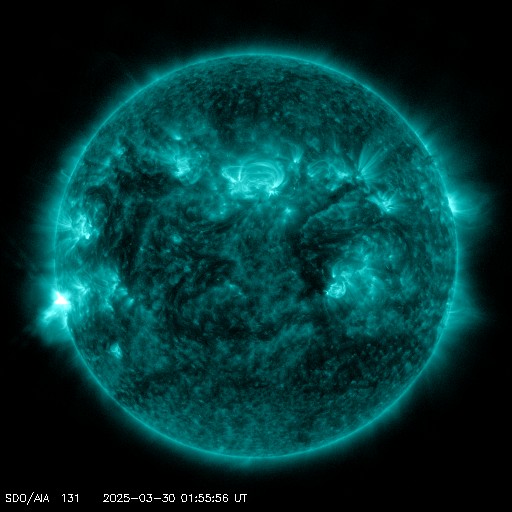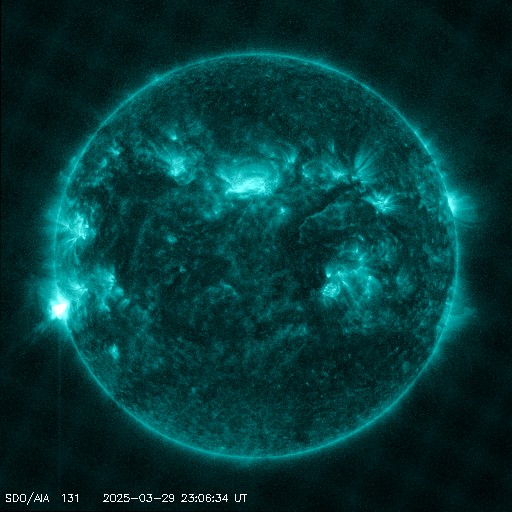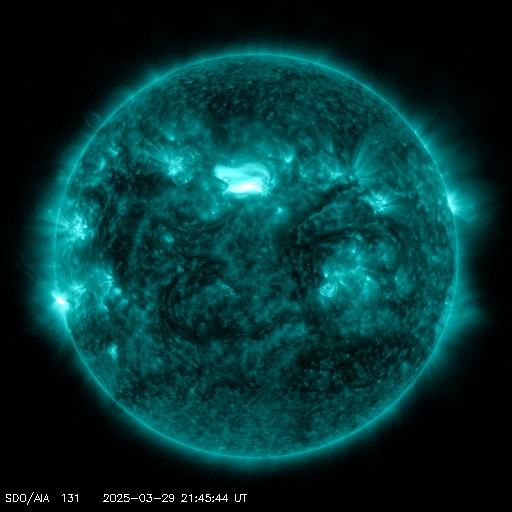Viewing archive of Friday, 8 June 2012
Solar activity report
Any mentioned solar flare in this report has a scaling factor applied by the Space Weather Prediction Center (SWPC). Because of the SWPC scaling factor, solar flares are reported as 42% smaller than for the science quality data. The scaling factor has been removed from our archived solar flare data to reflect the true physical units.
Report of Solar-Geophysical Activity 2012 Jun 08 2200 UTCPrepared by the NOAA © SWPC and processed by SpaceWeatherLive.com
Joint USAF/NOAA Report of Solar and Geophysical Activity
SDF Number 160 Issued at 2200Z on 08 Jun 2012IA. Analysis of Solar Active Regions and Activity from 07-2100Z to 08-2100Z
Solar activity was low. Region 1494 (S18W33) produced
a C7 flare at 08/0307Z. The flare was accompanied by Type II and
Type IV radio emissions at 08/0305Z and 08/0308Z, respectively. A
CME was observed in LASCO C2 imagery at 08/0443Z emerging from the
southern hemisphere. Analysis of LASCO and STEREO COR2 coronagraph
imagery indicated a speed of approximately 380 km/s. A subsequent
model run suggested a glancing blow at earth late on June 12th.
Filament eruptions were observed from the NE limb at 08/1645Z in SDO
304 imagery and at 08/1756Z in LASCO C2. A second eruption near
N10E50 was observed in SDO 304 imagery at 08/1706Z. The first
eruption is not expected to be geoeffective; the second is being
evaluted.
IB. Solar Activity Forecast
Solar activity is expected to be low
with a chance for an isolated M-class event for the next three days
(09-11 June).
IIA. Geophysical Activity Summary 07-2100Z to 08-2100Z
The geomagnetic field ranged from quiet to unsettled levels. Data
from the ACE spacecraft suggested the possible arrival of the CME
from 05 June around 08/0800Z. A couple of unsettled periods
followed, but most of the day was quiet. Wind speed at ACE declined
throughout the period and ended the day near 500 km/s. The Bz
component of the IMF was generally neutral to slightly negative for
the first half of the day, and generally positive for the last half.
The greater than 2 MeV electron flux at geosynchronous orbit was at
high levels throughout the period.
IIB. Geophysical Activity Forecast
The geomagnetic field is
expected to be at quiet levels on day 1 (09 June). The CME from 06
June is expected to arrive on day 2 (10 June), bringing unsettled
conditions with a chance for an isolated active period through day 3
(11 June).
III. Event Probabilities 09 Jun to 11 Jun
| Class M | 25% | 25% | 25% |
| Class X | 01% | 01% | 01% |
| Proton | 01% | 01% | 01% |
| PCAF | Green | ||
IV. Penticton 10.7 cm Flux
Observed 08 Jun 124 Predicted 09 Jun-11 Jun 125/125/130 90 Day Mean 08 Jun 117
V. Geomagnetic A Indices
Observed Afr/Ap 07 Jun 008/008 Estimated Afr/Ap 08 Jun 009/008 Predicted Afr/Ap 09 Jun-11 Jun 006/005-007/010-007/010
VI. Geomagnetic Activity Probabilities 09 Jun to 11 Jun
| A. Middle Latitudes | |||
|---|---|---|---|
| Active | 10% | 20% | 20% |
| Minor storm | 05% | 10% | 10% |
| Major-severe storm | 01% | 01% | 01% |
| B. High Latitudes | |||
|---|---|---|---|
| Active | 15% | 15% | 15% |
| Minor storm | 15% | 25% | 25% |
| Major-severe storm | 15% | 30% | 30% |
All times in UTC
Current data suggests there is a slight possibility for aurora to appear at the following high latitude regions in the near future
Gillam, MB, Yellowknife, NTLatest news
Latest forum messages
AR4046 129AR4048 20AR4043 47Incoming & Unnumbered Active Regions 1658Aurora photography hints for those of us with smartphones 51
More topicsSupport SpaceWeatherLive.com!
A lot of people come to SpaceWeatherLive to follow the Sun's activity or if there is aurora to be seen, but with more traffic comes higher server costs. Consider a donation if you enjoy SpaceWeatherLive so we can keep the website online!

Latest alerts
02:09 UTC - Solar flare
Moderate M1.54 flare from sunspot region 4048
01:42 UTC - Radio Blackout
Minor R1 radio blackout in progress (≥M1 - current: M1.24)
Saturday, 29 March 2025
23:21 UTC - Solar flare
Moderate M1.91 flare from sunspot region 4048
22:51 UTC - Radio Blackout
Minor R1 radio blackout in progress (≥M1 - current: M1.1)
21:57 UTC - Solar flare
Moderate M1.45 flare from sunspot region 4048
Space weather facts
| Last X-flare | 2025/03/28 | X1.1 |
| Last M-flare | 2025/03/30 | M1.5 |
| Last geomagnetic storm | 2025/03/27 | Kp5 (G1) |
| Spotless days | |
|---|---|
| Last spotless day | 2022/06/08 |
| Monthly mean Sunspot Number | |
|---|---|
| February 2025 | 154.6 +17.6 |
| March 2025 | 127.5 -27.1 |
| Last 30 days | 127.5 -24.7 |





